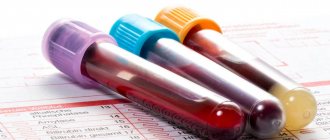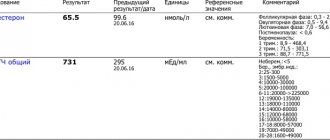Changes in coagulogram and clinical blood test parameters
Changes in the coagulogram of a pregnant woman are a natural physiological process associated with the appearance of the uteroplacental circulation. It is due to the fact that the pregnant woman’s body prepares for an increase in blood volume during pregnancy and for possible blood loss during childbirth.
During normal pregnancy, the activity of the blood coagulation system increases. This means that already in the 3rd month of pregnancy, fibrinogen increases, which reaches its maximum values on the eve of childbirth. Therefore, gynecologists reasonably recommend monitoring this indicator during pregnancy (once per trimester, if there are deviations in these indicators, more often, once a week).
Simultaneously with the increase in fibrinogen, the activity of the internal blood coagulation mechanism also increases, while the analysis shows a shortening of the activated partial thromboplastin time (aPTT). Other parts of the blood coagulation system, such as the coagulation blocker antithrombin III, also change during pregnancy. But as pregnancy progresses, there is a gradual decrease in the activity of this indicator.
But lupus anticoagulant should not be produced normally in a pregnant woman.
Pregnancy also affects the results of a general blood test. Indicators such as hemoglobin and hematocrit may decrease in the second half of pregnancy, and leukocytes, on the contrary, may increase.
Treatment
It is important to pay attention to nutrition, but this does not replace taking medications prescribed by your doctor. A pregnant woman in the second trimester needs 3 or 4 mg of iron per day. In the last 3 months of gestation, the need is greater; as already noted, it is approximately 10 mg. Diet to treat low hemoglobin in a pregnant woman is not enough. A day, eating right, you can get only 1 mg of iron with food, and this is too little.
If little iron is supplied with food, then the body will initially use what is stored in the depot “in reserve.” But by the twentieth week, in such a situation, it is already possible to receive a diagnosis of anemia.
There are 2 types of iron : heme and non-heme. The latter type is found in our food, but it is not reflected in the level of hemoglobin in the blood. This is another fact in favor of refuting the myth about adjusting hemoglobin levels during pregnancy with a balanced diet. Yes, eating right is important, but in the case of anemia, it is only one step towards recovery.
Leading products in iron content:
- liver
- meat
- eggs
- fish
- spinach
- apricot
- pomegranate
- oatmeal
- beet
- peaches
The human body absorbs about 6% of iron from animal products, and 0.2% of the total iron it contains from plant products.
Treatment with drugs
To adjust hemoglobin levels, it is important to take medications with heme iron. Its absorption occurs at a higher level, so there is more hemoglobin in the blood in a short time. The drugs must be prescribed on a case-by-case basis by the attending physician. The dosage may vary for all pregnant women.
Drugs for the treatment of anemia:
- Maltofer
- Tardiferon
- Sorbifer
- Totema
- Ferrum Lek
When prescribing, the doctor takes into account the degree of anemia the patient has and whether she has intolerance to the drug.
Changes in biochemical parameters
During pregnancy, a decrease in the total concentration of protein in the blood plasma (albumin) is due to partial dilution of the blood due to an increase in its total volume. But it can occur as a result of fluid retention in the body, hemodynamic disturbances, and increased vascular permeability during pregnancy.
Changes in the concentration of blood proteins are detected on the proteinogram. In the first and second trimester of pregnancy, albumin decreases. In the third trimester, an increase in the alpha-1-globulin fraction, alpha-fetoprotein, is detected.
The alpha-2-globulin fraction can increase due to proteins associated with pregnancy (begin to increase from 8-12 weeks of pregnancy and reach a maximum in the third trimester). Betta and gamma globulins also increase. Minor changes in C-reactive protein, observed more often in the early stages of pregnancy, may be the body’s reaction to the processes of increased cell division during the growth and development of the baby.
Changes in circulating blood volume (CBV) and blood supply to the kidneys lead to changes in the excretory function of the kidneys. There is a delay and accumulation of nitrogenous substances, while the amount of urea decreases, especially in late pregnancy. Creatinine levels decrease maximally in the 1st-2nd trimester (its concentration can decrease by almost 1.5 times), which is associated with muscle growth in the mass of the uterus and child. The level of uric acid is often reduced due to increased blood supply to the kidneys. But even minor disturbances in kidney function can lead to an increase in this indicator, and this is regarded as a possible symptom of intoxication.
Fat metabolism changes significantly during pregnancy. Since metabolic processes in the body intensify, cholesterol levels (cholesterol, high-density lipoprotein HDL) increase.
An increase in the level of estrogen hormones during pregnancy leads to the deposition of fat in the mammary glands, waist and buttocks. Therefore, losing weight and going on diets is useless for pregnant women. This is hormonal and will go away only after the child is one year old, almost regardless of whether the mother breastfeeds or not.
During pregnancy, insulin levels increase. The indicator reflecting the level of insulin is C-peptide. In this case, the glucose level may change slightly or not change at all.
However, glucose can be detected in urine during normal pregnancy. This happens because during pregnancy the rate at which urine is filtered through the kidneys increases. Most often, glucose in the urine appears during pregnancy 27-36 weeks.
Features of mineral metabolism in healthy pregnant women compared to non-pregnant women is the retention of sodium, potassium, chlorine, and phosphorus salts in the body. And it is precisely the changes in phosphorus levels in the pregnant woman’s body that are associated with an increase in alkaline phosphatase. This is due to changes during pregnancy in bone tissue and changes in the liver.
As you know, during pregnancy the need for calcium salts, which are necessary for the formation of the baby’s skeleton, increases. Therefore, the mother may experience calcium deficiency, which sometimes manifests itself in muscle cramps.
Increased iron consumption by the body of a pregnant woman can lead to anemia. This condition is characterized by a decrease in iron, ferritin, vitamins: B12, folic acid.
Why does anemia occur?
The main causes of anemia are:
- Iron deficiency if: there is not enough of it in food (unbalanced diet);
- it is not absorbed due to gastrointestinal problems;
- it is lost due to bleeding (hemorrhoids, exacerbation of peptic ulcer, taking drugs with salicylic acid or anticoagulants; myomatous nodes or hyperplasia, etc.).
The daily iron requirement of an adult is about 2 mg, and is usually met by dietary iron intake. A typical diet provides 5–15 mg of essential iron per day, of which about 10% is absorbed in the gastrointestinal tract.
Iron is distributed in the body as follows:
- Hemoglobin 1.5–3.0 g.
- Reserve iron (depot) - 0.5–1.5 g.
- Myoglobin, enzymes - 0.5 g.
- Transport iron - 0.003–0.004 g.
Normal iron reserves are about 1 g (1000 mg), they are stored in the liver and spleen in the form of compounds with proteins (ferritin, hemosiderin). If necessary, reserve iron in the form of ferritin is quickly released from the depot and enters the bone marrow to form hemoglobin.
Serum iron (or transport) continuously circulates in the blood, constantly entering the bone marrow for hemoglobin synthesis, into tissues for cellular respiration and into depot organs to replenish reserves. By its level you can judge the deficiency or saturation of the body with iron. When monitoring the level of serum iron in the blood, you should not take iron supplements for 3 days before the test.
The consequences of iron deficiency anemia during pregnancy are quite serious:
- In 30–50% of pregnant women, gestosis develops against the background of anemia (swelling, increased blood pressure, protein in the urine);
- In 10–40%, premature birth and weakness of labor are possible;
- One in 10 pregnant women suffers from postpartum hemorrhage;
- In 20%, fetal malnutrition (growth retardation) is detected;
- 10% have miscarriage.
During pregnancy, iron requirements increase to 6–8 mg/day by 32 weeks. These requirements can only be achieved by additional intake of iron into the body.
Pregnancy - III trimester
A complex test, including a group of laboratory tests to determine the general health, functioning of the main systems and organs of a pregnant woman in the third trimester of pregnancy.
Synonyms Russian
Pregnancy, III trimester.
English synonyms
Pregnancy third (III) trimester.
What biomaterial can be used for research?
Venous blood, an average portion of morning urine.
How to properly prepare for research?
- Eliminate alcohol from your diet for 24 hours before the test.
- Eliminate fatty foods from your diet for 24 hours before the test.
- Do not eat for 12 hours before the test; you can drink clean still water.
- Avoid (in consultation with your doctor) taking diuretics for 48 hours before collecting urine.
- Completely avoid (in consultation with your doctor) taking medications for 24 hours before the test.
- It is recommended to collect urine before menstruation or 2-3 days after it ends.
- Avoid physical and emotional stress for 30 minutes before the test.
- Testing for HIV infection can be carried out anonymously and confidentially. During a confidential examination, it is mandatory to present a passport.
- Do not smoke for 30 minutes before the test.
General information about the study
The third (III) trimester of pregnancy includes the period between 27 (28) and 38 (40) weeks of pregnancy. During this period, active growth of the fetus occurs, improvement of organ systems, in particular the respiratory system, development of sensory organs, and maturation of the nervous system. Clinical laboratory diagnostics are aimed at assessing the functioning of major organs and systems, in particular the kidneys, liver, blood coagulation system, endocrine system of a pregnant woman, as well as controlling infection during pregnancy.
A clinical blood test allows you to evaluate the qualitative and quantitative composition of blood according to the main indicators: red blood cells, leukocytes and their varieties in absolute and percentage terms, platelets. Detection of deviations in these indicators may indicate the presence of pathological processes and diseases in a pregnant woman. A reduced number of red blood cells and the hemoglobin content in red blood cells may indicate the presence of anemia in pregnant women. This condition can lead to placental insufficiency - the main cause of miscarriage, low birth weight babies and fetal death. Changes in the leukocyte formula may indicate a wide range of changes in the body of a pregnant woman. These may be laboratory signs of inflammatory and infectious diseases, pathologies that a woman has, but have not previously been diagnosed. The platelet count during pregnancy may be lower than normal, which must be taken into account. Significant changes in these indicators and developing thrombocytopenia require special monitoring, as they may be indirect signs of pathologies of the blood coagulation system, as well as such a severe complication of pregnancy as DIC syndrome (disseminated intravascular coagulation syndrome). Changes in ESR can be observed in the presence of acute and chronic inflammatory diseases and infectious processes. A slight increase in ESR can be observed during pregnancy. This test has high sensitivity but low specificity and is prescribed in combination with other indicators.
A general urinalysis with microscopy of urinary sediment is a set of diagnostic tests that allow one to assess the general properties of urine, its physicochemical properties, the content of metabolic products, and identify the qualitative and quantitative content of a number of organic compounds. These tests reflect the functional state of the kidneys and urinary tract, allow one to judge general metabolic processes, and suggest the presence of possible disorders, infectious and inflammatory processes. The detection of glucose and ketone bodies in the urine may indicate the development of impaired carbohydrate tolerance, diabetes mellitus, and pregnancy diabetes. Detection of protein in the urine may be a sign of developing nephropathy in pregnancy; proteinuria more than 0.3 g in daily urine may indicate the development of a severe complication of pregnancy - preeclampsia. The severity of this condition varies greatly. Thus, with the development of mild preeclampsia after 36 weeks, the prognosis is usually favorable. On the contrary, the threat to the health of the mother or fetus increases significantly if preeclampsia develops early (before 33 weeks) and is aggravated by the presence of concomitant diseases.
In the third trimester of pregnancy, it is also necessary to monitor the functional state of the blood coagulation and fibrinolysis system. The prothrombin time test is used to evaluate the extrinsic clotting pathway. The following indicators are obtained as results: Quick prothrombin time and international normalized ratio. Activated partial thromboplastin time (aPTT) characterizes the intrinsic pathway of blood coagulation. Fibrinogen is factor I (the first) factor of the blood plasma coagulation system. These indicators make it possible to assess the functional state of the liver, the main pathways of the blood coagulation system, and assess the functional state of its components. Their determination is important for predicting thrombosis during pregnancy, diagnosing a complication such as disseminated intravascular coagulation syndrome, and planning the necessary therapy during childbirth - a process accompanied by massive blood loss. It should be noted that there is a physiological increase in the levels of prothrombin and fibrinogen in the third trimester of pregnancy. But a sharp increase in these indicators requires special monitoring and prescription of the necessary therapy. The level of D-dimer also increases during the physiological course of pregnancy, especially at 35-40 weeks, but a sharp increase in the concentration of D-dimer may indicate a large number of blood clots, which is most often caused by venous thromboembolism or disseminated intravascular coagulation syndrome.
Determination of such biochemical parameters as alanine aminotransferase (ALT), aspartate aminotransferase (AST), total bilirubin and direct bilirubin fraction, total protein in serum allows us to assess the functional state of the liver. ALT levels may be slightly elevated, while AST levels are decreased. A significant increase in the concentration of transaminases may indicate the presence of liver damage, hepatitis, and the development of preeclampsia. A decrease in the level of total protein in the blood serum along with the loss of protein in the urine and with an increase in blood pressure more than 140/90 mm Hg. Art. is also a sign of developing preeclampsia.
To exclude the development of diabetes in pregnant women (gestational diabetes), the development of complications, in particular diabetic nephropathy, it is necessary to determine the level of glucose in the blood plasma.
To assess the functional state of the kidneys, in particular the integrity of glomerular filtration processes, several diagnostic parameters are used. The most important and characteristic is the determination of the levels of urea and creatinine in the blood serum, as well as the assessment of the glomerular filtration rate. It is important that creatinine levels are reduced by almost half in pregnant women due to increased blood volume, increased blood flow in the kidneys and, accordingly, an increased degree of filtration. Also, an increase in renal filtration causes a decrease in the amount of urea in pregnant women.
Typically, pregnancy occurs with normal levels of thyroid-stimulating hormone (TSH) in the blood. This euthyroid state is maintained by all components of the thyroid system and placental hormones, in particular human chorionic gonadotropin and human chorionic thyrotropin. The thyroid hormone systems of the mother and fetus are independent of each other and weakly penetrate the mature placenta. The TSH level in the blood of pregnant women may increase with the development of preeclampsia.
In the third trimester of pregnancy, it is also recommended to retest for hepatitis B - HBsAg, hepatitis C - anti-HCV, antibodies, HIV infection - HIV 1.2 Ag/AbCombo (determination of antibodies to HIV types 1 and 2 and p24 antigen), syphilis - antibodies to Treponema pallidum. The incubation period for some infections varies greatly and a negative result from tests taken early in pregnancy may change in the last weeks of pregnancy or remain negative. This is necessary to prevent infection of the fetus during childbirth, prescribe the necessary treatment or perform a planned cesarean section.
What is the research used for?
- For preventive examination of pregnant women in the third trimester of pregnancy.
- If there is a suspicion of deviations in the normal functioning of the systems and organs of pregnant women.
- To diagnose complications of the third trimester of pregnancy.
When is the study scheduled?
- Pregnant women in the third trimester at 27-38 (40) weeks of pregnancy.
What do the results mean?
Reference values
For each indicator included in the complex:
- [02-005] Clinical blood test (with leukocyte formula)
- [02-006] Urinalysis with microscopy
- [02-007] Erythrocyte sedimentation rate (ESR)
- [03-001] D-dimer
- [03-003] Activated partial thromboplastin time (APTT)
- [03-007] Coagulogram No. 1 (prothrombin (according to Quick), INR)
- [03-011] Fibrinogen
- [06-003] Alanine aminotransferase (ALT)
- [06-010] Aspartate aminotransferase (AST)
- [06-015] Plasma glucose
- [06-021] Serum creatinine (with GFR determination)
- [06-034] Serum urea
- [06-035] Total protein in serum
- [06-036] Total bilirubin
- [06-037] Direct bilirubin
- [07-009] anti-HCV, antibodies
- [07-025] HBsAg
- [07-032] HIV 1.2 Ag/Ab Combo (determination of antibodies to HIV types 1 and 2 and p24 antigen)
- [07-049] Treponema pallidum, antibodies
- [08-118] Thyroid-stimulating hormone (TSH)
What can influence the result?
- The use of medications, in particular hormonal ones.
Who orders the study?
Obstetrician-gynecologist, general practitioner, endocrinologist, therapist, infectious disease specialist.
Literature
- Dolgov V.V., Menshikov V.V. Clinical laboratory diagnostics: national guidelines. – T. I. – M.: GEOTAR-Media, 2012. – 928 p.
- Moon HW, Chung HJ, Park CM, Hur M, Yun YM1. Establishment of trimester-specific reference intervals for thyroid hormones in Korean pregnant women / Ann Lab Med. 2015 Mar;35(2):198-204.
- Angueira AR, Ludvik AE, Reddy TE, Wicksteed B, Lowe WL Jr, Layden BT. New insights into gestational glucose metabolism: lessons learned from 21st century approaches. / Diabetes. 2015 Feb;64(2):327-34. doi: 10.2337/db14-0877.
- Poon LC, Nicolaides KH. Early prediction of preeclampsia. Obstet Gynecol Int. 2014;2014:297397. Review.
- Fauci, Braunwald, Kasper, Hauser, Longo, Jameson, Loscalzo Harrison's principles of internal medicine, 17th edition, 2009.









